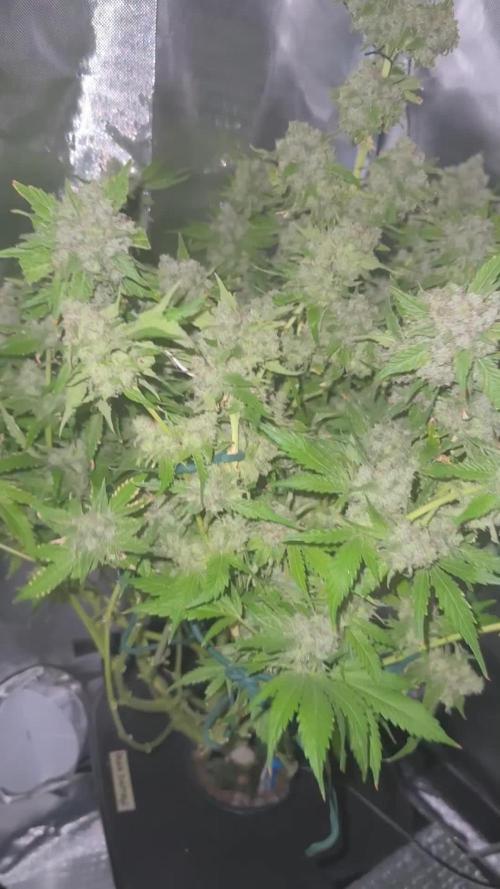The Grow Awards 2026 🏆 































Likes
20
Share


@Doofy
Follow
She appears to be doin good. She was 2 weeks later in flowering, so she still got time. I'm guessing another 2 weeks 👍
She is not gaining anymore...
Likes
151
Share


@CANNASIM
Follow
------GENERAL COMMENT------
We arrived pass mid flowering as we are now starting week 5 of flower. No issues, bumped up a bit the Sensi Bloom to 2.5 after 3ml, and have seen the girls darken a bit, so i decided to go down a bit to 2ml this week, maybe stick to this dosage depending how the girls react.
The tent have become small for or two ladies, no way to train them more, there is no space. Decided to move forward without a mid grow flush.
Still on the 1.5l of water every other day, one base + recharge + pk booster, other with pk booster + natures candy + velokelp alternating.
Today was the last Pk booster - Big Bud dose, now we will cut the Big Bud and enter with the Overdrive, the rest will be as is.
------SM.BB COMMENT------
The blueberry is darker than the AK, presenting no signs of overfert, tips are ok, and no spotting, buds are becoming fat and resinous.
Likes
5
Share


@Elmike
Follow
En cette première journée de la semaine j'ai bien arrosé mes filles de leurs mélange favoris. J'ai donné beaucoup d'amour à mes filles en cette journée de St-Valentin ❤️
Likes
8
Share


@CULTMEN
Follow
Bravo, I am surprised by the fast buds 420, quality seems
Both are 46 days old
Gorilla Zkittlez Auto
And Gorilla Cookies FF let's see what happens next week 🌲🌱💚🌵🌧️🌦️
Likes
10
Share


@TheCannaProphet
Follow
~ DUTCH PASSION / SUPER SATIVA SEED CLUB FAST FLOWER 'TESTER' A and 'TESTER' B ~
Well cannafam, here we go again on another growing adventure together! This diary will be special to me for two reasons, one because I have the opportunity to cultivate some new and exciting strains from two of the TOP breeders in the industry! The second reason this will be special to me is that I will be growing these two strains in a brand new greenhouse that I put up! I'm super stoked to see how these two ladies turn out in this new setup.
On to the strains:
'Tester' Strain A info: Hybrid (I/S) | 6-7 weeks flowering | Fruity, Sweet, Candy
'Tester' Strain B info: Indica-Dominant (90%) | 7 weeks flowering | Fruity, Peppery, Sweet
I hope that you enjoy this run as much as I will... It's going to be fun and interesting for sure!
~GROW WHAT YOU LOVE, LOVE WHAT YOU GROW!~
____________________________________________________________________________________________________________________________________________________________________________________________________________________________________________________________________________________________________________________________
The Setup:
These beauties will be growing in a brand spanking new 10x14' greenhouse that I have equipped with automatic window openers, a complement of Hurricane fans and a de-humidifier/heater to help keep the environment as dialed in as possible.
I started both tester in glasses of tap water, where they soaked for 24hrs. After soaking, they were placed directly into whole eggshells with just their tops removed to make a natural seed starting pot that I filled with a 70/30 blend of Coco/Perlite which was pre-moistened with well water ph'd to 6.2, then placed under a 50w full spectrum LED on a 24hr light schedule.
Once, they both have their second set of leaves emerged, I plan on starting to put them in the greenhouse for 2-3 hour a day for a few days to help them acclimate and 'harden off' in the greenhouse. I'll be starting both off in 1qt pots, then transplanting them into to gradually larger pots until they're around 6 weeks old, then they will go into their final pots which are 25g fabric pots.
I mix my initial medium using 3 tbsp/g of Gaia Green Organics 4-4-4 along with 1 tbsp/g of Gaia Green Organics Glacial Rock Dust for the trace minerals it provides, 1 tbsp/g of Down To Earth Kelp Meal, 1 tbsp/g of Trichoderma/Mycorrhizae, and 1 cup/g of Wiggle Worm Castings. I hand mix my amendments to ensure an even distribution throughout the medium. I'll be watering with well water ph'd to 6.2-6.8 and providing bi-weekly compost tea's throughout the run.
____________________________________________________________________________________________________________________________________________________________________________________________________________________________________________________________________________________________________________________________
Weekly Updates:
5/1- Week Three of veg is here for the pair of 'Testers' from SSSC/Dutch Passion Seeds. Both 'Testers' continue to do exceptionally well despite temp's in the greenhouse reaching just over 90℉ at the peak of the day. Both continue to show great vigor, color and are both constantly 'praying'!
5/3- Watering both continues every 2-3 days depending on what the plants want. Both girls are looking like champs!
5/5- Today I watered both with 8oz. of well water, to which I added 1 tsp. of Uncle Willies Worm Tea Concentrate.
5/6- Well fam, the Third week of veg is in the rear view mirror for these two beautiful 'Testers' from SSSC and Dutch Passion. Unfortunately, I have to go out of state for 7-10 days because of a family emergency, so I won't have pic's for next week. I will have a family member looking after the plants in the greenhouse to make sure all survive until I return! Give your loved one's a hug and tell them that you love them... you never know when you'll never have the chance to do it again! Blessings to all!😎🙏
Thank you for visiting my diary, I hope you will follow along and hope you enjoy what I do! Stay Blessed!😎💚
Likes
23
Share


@Horseluisweed
Follow
Básicamente lo mismo, aunque está semana pilló bastante más horas de luz(tuve que irme fuera de casa dos findes seguidos, en los cuales la dejé con la luz encendida full 24/7 en la caja)
Como experiencia utilicé café reposado 48h para "alimentarla" e intentar bajar el Ph de la tierra (coco ph6+hummus ph7+vermiculita ph8= ph total 7)
El otro experimento fue cubrir la tierra con coco para que el tallo eche raíces y aprovechar su espigamento!
Las horas de luz solía dejarla 8h en bombilla mientras duermo, y el día la pongo en la ventana a que tome el fresco, pero apenas tiene luz directa, me da la sensación que crece más rapido cuando vuelvo del finde, estoy replanteandome tenerla más tiempo en la caja con luz, porque la veo aún pequeña, y quizá ponerle un ventilador de pc o algo🤔..veremos, aún tengo el papel de aluminio al lado de la caja y ni se lo he puesto, con eso os lo digo todo☝️🎃
Likes
3
Share


@Easygrower
Follow
Hello growers welcome to harvest day 82 I did cut her down at day 75 so very quick plant indeed for the first 10 days I gave her water from my tap not ph at all from there she got bio grow/bloom until I see her first pistols from there I gave her bio grow/bloom/top max/bio heaven up to day 61 I then flushed for two weeks then cut her down I had her in a 20/4 light cycle from start to finish she was very easy to grow and has give me some very nice buds smelling like pear drops bang bang that’s it for now happy growing and be safe ✌️
Likes
5
Share


@pzwags420
Follow
The start of week 5 is going well. Blueberry is smelling nice and my seedlings should be showing preflowers soon.
Likes
16
Share


@Chubbs
Follow
420Fastbuds
FBT2310/Week 7
What up grow fam. Happy Easter to all. Weekly update for these two stunning girls. Where in the 3rd week of Flower and they are swelling up nice. I did notice some fad in the leafs so I upped my nitrogen a little and it seemed to stop the problem. All in all Happy Growing
Likes
5
Share


@killerjoint
Follow
10-8-2024 TOP DRESSING AND WORM TEA.....
NOTHING MORE
10-9-2024 22ND DAYS INTO FLOWERING
SMELLS CRAZY ON THESE STRAIN
GETTING SOME SNOW ON TOP
LET'S GO
10-11-2024 DO NOT HAVE ANY PEST BUT JUST IN CASE
NATURESGOODGUYS HOOK ME UP WITH LADYBUGS
JUST GOT HANGING PATCH ABOUT /WITH SHIPPING
10-14-24 NOTHING TO DO...JUST WATER (PH6.6)AND WATCHING THE PLANTS.......
COPY CAT GENETIX STRAINS ARE CRAZY!!!!!!!!
Likes
16
Share


@HegauHillsFarmers_M11
Follow
Tag 63 - Beginn der 10 Woche.
Die Blüte reift! Die Buds sehen super aus, sind dick und sind ordentlich frostig. Der Geruch wird auch immer schärfer und intensiver. Die Blüten duften süßlich und man schmeckt auch das Diesel schön heraus.
Aktuell wird die Pflanze mit Flawless Finish gespült. Dabei gebe ich immer 1,5 - 2ml/l zum ganz normalen Gießwasser hinzu. Dieser Vorgang wurde bis jetzt 4x wiederholt.
Likes
11
Share


@Mo_Powers
Follow
the first week is behind us. the weather is still very changeable. a lot of rain and not yet the desired daytime temperatures. the little one is growing, but is taking her time.
Likes
9
Share


@Enki_Weed
Follow
In den letzten ein bis zwei Wochen hat sich unsere Pflanze weiterhin prächtig entwickelt und zeigt nun deutliche Anzeichen einer fortgeschrittenen Blütephase. Es gab keine dramatischen Veränderungen, sondern eine stetige Reifung, die uns dem Erntezeitpunkt näherbringt.
Die Pflanze präsentiert sich sehr buschig und vital, mit zahlreichen dichten Blütenständen, die sich gut ausgebildet haben (siehe Gesamtansicht der Pflanze). Die Buds sind kompakt und haben in den letzten Wochen an Volumen und Gewicht zugelegt. Man kann deutlich sehen, wie die Blütenkelche anschwellen und sich zu reifen Blütenständen formen.
Trichom- und Stigmen-Reife:
Ein genauerer Blick auf die Buds (wie im ersten Nahaufnahme-Bild der Trichome und im weiteren Nahaufnahme-Bild der Buds mit orangenen Stigmen ersichtlich) zeigt den Fortschritt der Reifung. Die weißen, harzigen Trichome bedecken die Blütenstände in Hülle und Fülle, was auf eine intensive Produktion von Cannabinoiden hinweist. Bei den Trichomen ist nun eine gute Mischung aus milchig-trüben Köpfen zu erkennen, die auf die volle Potenz hindeuten. Erste bernsteinfarbene Trichome beginnen ebenfalls aufzutreten, was ein Zeichen dafür ist, dass der Erntezeitpunkt bevorsteht.
Parallel dazu haben sich die Stigmen (die feinen Härchen auf den Buds) von Weiß zu einem satten Orange-Braun verfärbt. Dies ist ein weiteres starkes Indiz für die Reife der Blüten und die nahende Ernte.
Blattwerk und Nährstoffbedarf:
Das Blattwerk der Pflanze ist größtenteils weiterhin gesund und grün, was auf eine gute Nährstoffversorgung schließen lässt. Einige der größeren Fächerblätter können in dieser späten Blütephase leichte Anzeichen von Vergilbung zeigen, da die Pflanze ihre Energie nun primär in die Blütenentwicklung steckt und Nährstoffe aus den Blättern zieht. Dies ist ein natürlicher Prozess, der oft als "Herbstfärbung" bezeichnet wird.
Wir werden die Reifung der Trichome weiterhin genauestens beobachten, um den optimalen Erntezeitpunkt zu bestimmen, der je nach gewünschtem Effekt variieren kann. Auch die allgemeine Gesundheit der Pflanze wird weiterhin im Auge behalten, um sicherzustellen, dass sie bis zur Ernte optimal versorgt ist.
Likes
9
Share


@MuzzFuzz
Follow
Things ticking along no real stresses this week. Starting to show some white hairs and still stretching. Temps and humidity much better this week and a lot easier to manage without the co2.
Likes
10
Share


@Aekarath
Follow
สัปดาห์นี้ผมได้ทำการเทรนต้นโดยใช้วิธี Lst ต้น ดัดยังไงก็ได้ครับให้ทุกยอดโดนแสงให้มากที่สุด พืชของเราได้จะได้เพิ่มผลผลิตได้มากที่สุด ปุ๋ยน้ำก็ปกติ ปุ๋ยผมให้ สัปดาห์ละ 2 ครั้ง ส่วนน้ำจะให้ตอนหน้าดินแห้งนะครับ อย่าลืม ปรับค่า ph ก่อนรดน้ำนะครับ
Likes
3
Share


@High_Grade_Dadli
Follow
Mother: to the older sets that are in pot
Gonna transplant dem new mother by the end of the week or next week...jus letting LST do it thing since I already started it
New cutting first visible root in 8 day off of water only gonna hit them with a rooting mixture before end of week




















